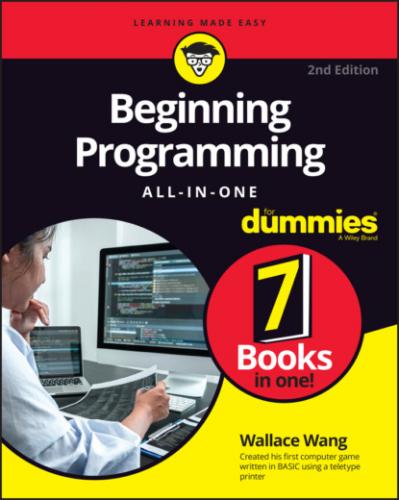12 Index
List of Tables
1 Book 1 Chapter 3TABLE 3-1 Popular “Battling Robot” Programming Games
2 Book 2 Chapter 2TABLE 2-1 Typical Storage Requirements for Different Data Types
3 Book 2 Chapter 3TABLE 3-1 Examples of Using the Assignment (=) OperatorTABLE 3-2 Common Mathematical OperatorsTABLE 3-3 Operator PrecedenceTABLE 3-4 Common Built-In Math FunctionsTABLE 3-5 Common Built-In String FunctionsTABLE 3-6 Examples of Pattern-Matching with Different Regular ExpressionsTABLE 3-7 Common Comparison OperatorsTABLE 3-8 The And Truth TableTABLE 3-9 The Or Truth TableTABLE 3-10 The Xor Truth Table
4 Book 2 Chapter 4TABLE 4-1 Multiple Boolean Expressions Ultimately Evaluate to a Single True or F...
5 Book 2 Chapter 5TABLE 5-1 A Database of Employee Names Assigned with Specific Employee ID Number...
6 Book 4 Chapter 1TABLE 1-1 Comparison of Different Sorting Algorithms
7 Book 4 Chapter 3TABLE 3-1 Single Pattern Regular ExpressionsTABLE 3-2 Calculating a Soundex Code
8 Book 4 Chapter 4TABLE 4-1 Rotating and Sorting Data
9 Book 5 Chapter 1TABLE 1-1 HTML Color Codes
10 Book 5 Chapter 3TABLE 3-1 Mathematical OperatorsTABLE 3-2 Relational OperatorsTABLE 3-3 Logical OperatorsTABLE 3-4 Assignment Operators
11 Book 5 Chapter 4TABLE 4-1 Mathematical OperatorsTABLE 4-2 Relational OperatorsTABLE 4-3 Logical operatorsTABLE 4-4 Assignment Operators
12 Book 5 Chapter 5TABLE 5-1 Mathematical OperatorsTABLE 5-2 Relational OperatorsTABLE 5-3 Logical OperatorsTABLE 5-4 Assignment Operators
13 Book 6 Chapter 1TABLE 1-1 Typical Storage and Range Limitations of C/C++ Integer Data TypesTABLE 1-2 Typical Floating-Point Data TypesTABLE 1-3 Mathematical OperatorsTABLE 1-4 Relational OperatorsTABLE 1-5 Logical OperatorsTABLE 1-6 Assignment Operators
14 Book 6 Chapter 2TABLE 2-1 Typical Storage and Range Limitations of Java Integer Data TypesTABLE 2-2 Typical Storage and Range Limitations of C# Integer Data TypesTABLE 2-3 Typical Floating Point-Data TypesTABLE 2-4 Mathematical OperatorsTABLE 2-5 Relational OperatorsTABLE 2-6 Logical OperatorsTABLE 2-7 Assignment Operators
15 Book 6 Chapter 3TABLE 3-1 Mathematical OperatorsTABLE 3-2 Relational OperatorsTABLE 3-3 Using Perl's Comparison with Signed Result OperatorTABLE 3-4 Logical OperatorsTABLE 3-5 Assignment Operators
16 Book 6 Chapter 4TABLE 4-1 Kotlin Integer Data TypesTABLE 4-2 Kotlin Floating-Point Data TypesTABLE 4-3 Mathematical OperatorsTABLE 4-4 Relational OperatorsTABLE 4-5 Logical Operators
17 Book 6 Chapter 5TABLE 5-1 Swift Integer Data TypesTABLE 5-2 Swift Decimal Data TypesTABLE 5-3 Mathematical OperatorsTABLE 5-4 Relational OperatorsTABLE 5-5 Logical Operators
18 Book 6 Chapter 6TABLE 6-1 Mathematical OperatorsTABLE 6-2 Relational OperatorsTABLE 6-3 Logical OperatorsTABLE 6-4 Assignment Operators
19 Book 7 Chapter 5TABLE 5-1 Understanding the Different Generations of Computing
List of Illustrations
1 Book 1 Chapter 1FIGURE 1-1: A processor uses its registers to temporarily store data.FIGURE 1-2: An editor lets you write and edit the source code of a program.
2 Book 1 Chapter 2FIGURE 2-1: Constantly modifying a program eventually creates an unorganized me...FIGURE 2-2: Sequences consist of groups of commands that the computer follows, ...FIGURE 2-3: Branches let the computer choose which group of commands to run at ...FIGURE 2-4: You can store subprograms in one big file or in separate files.FIGURE 2-5: Designing a UI involves drawing what you want to appear on your pro...FIGURE 2-6: Properties define how each part of a UI looks and behaves.FIGURE 2-7: An event handler tells the UI how to behave when the user does some...FIGURE 2-8: Object-oriented programming never physically copies code but “point...
3 Book 1 Chapter 3FIGURE 3-1: Programming in Scratch means connecting visual building blocks toge...FIGURE 3-2: LEGO Mindstorms programming connects visual building blocks togethe...FIGURE 3-3: An Alice program creates an animated character onscreen and moves i...FIGURE 3-4: Using a battling robot to study programming can make programming mo...FIGURE 3-5: The .NET framework can tie programs, written in multiple languages,...FIGURE 3-6: Recording keystrokes automatically creates the equivalent VBA code ...
4 Book 1 Chapter 4FIGURE 4-1: Compiler optimization settings let you make your program as small a...FIGURE 4-2: A cross-compiler lets you write a program and compile it for multip...FIGURE 4-3: The Flutter website lets you type and run code using any browser.FIGURE 4-4: A virtual machine acts like a combination of an interpreter and a c...FIGURE 4-5: An IDE provides access to multiple programming tools within a singl...FIGURE 4-6: Stepping through a program, line-by-line, can help you find errors ...FIGURE 4-7: Breakpoints let you skip over parts of your program that you don’t ...FIGURE 4-8: The step over command lets you skip, or “step over,” the lines stor...FIGURE 4-9: Watching and changing variables can show you how a program reacts t...
5 Book 2 Chapter 1FIGURE 1-1: If you put enough commands together, you can create any type of pro...FIGURE 1-2: Multiple keywords, along with various symbol characters, can create...FIGURE 1-3: Dividing a large program into parts can make it easier to find spec...FIGURE 1-4: Subprograms create reusable building blocks that you can use to mak...FIGURE 1-5: Storing subprograms in separate files can make it easier to read an...FIGURE 1-6: Subprograms give you the option of using different programming lang...FIGURE 1-7: Changing one part of a program can affect other parts of that same ...FIGURE 1-8: Object-oriented programming divides your program into logical parts...FIGURE 1-9: The UI accepts data and displays the results of its calculations ba...FIGURE 1-10: Creating a UI involves picking common items, such as buttons and c...
6 Book 2 Chapter 2FIGURE 2-1: If a program tries to store the wrong type of data in a variable, t...FIGURE 2-2:
